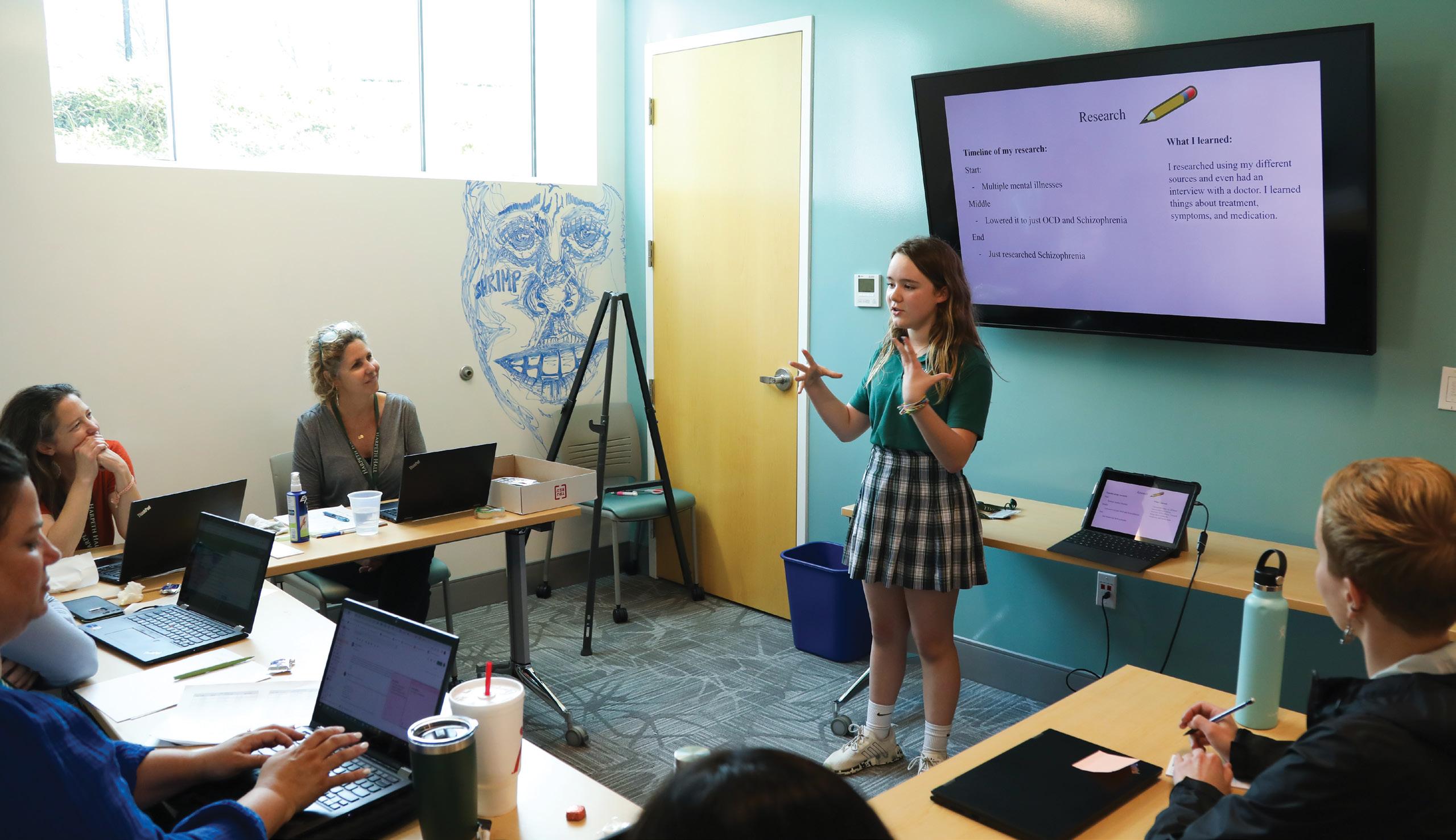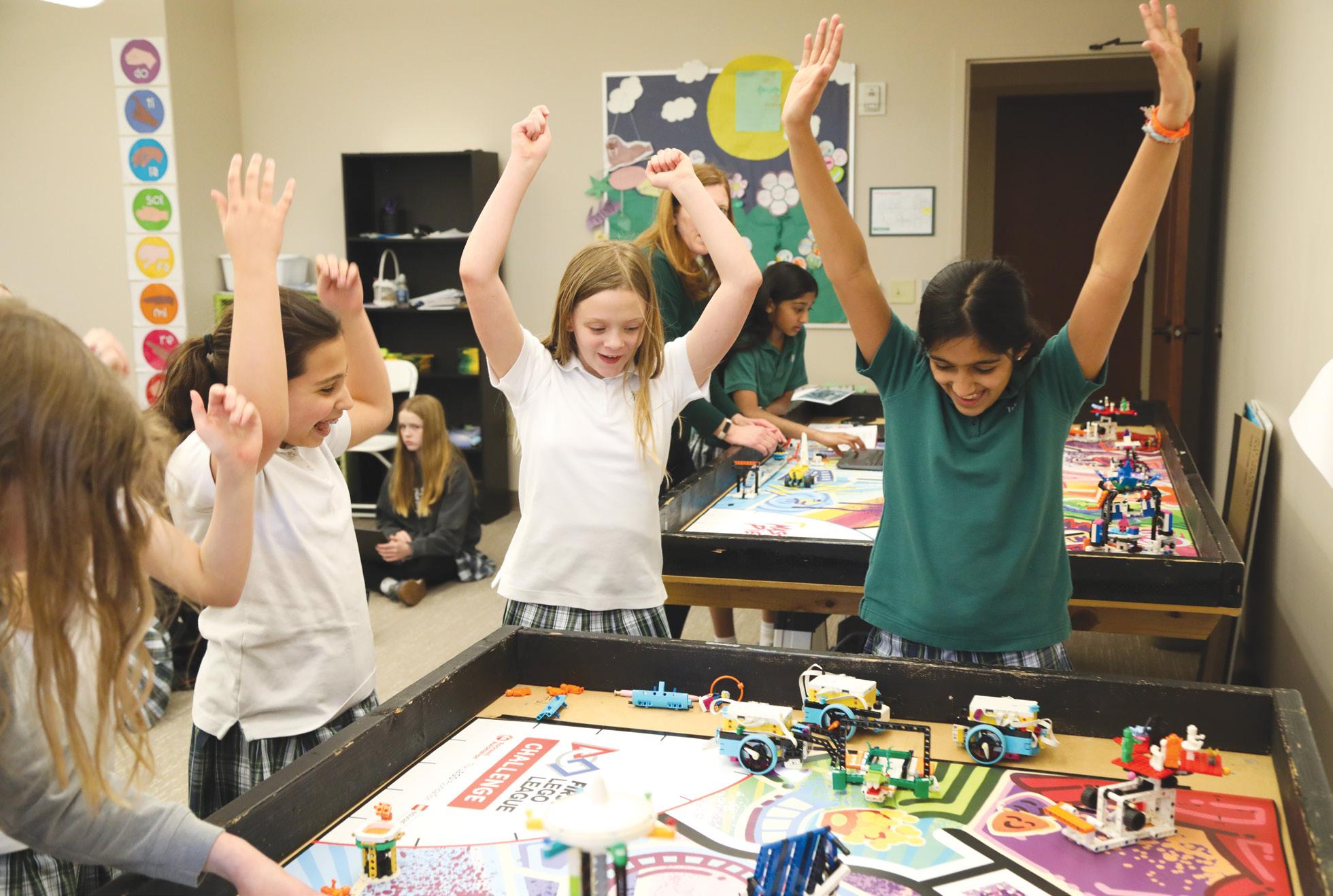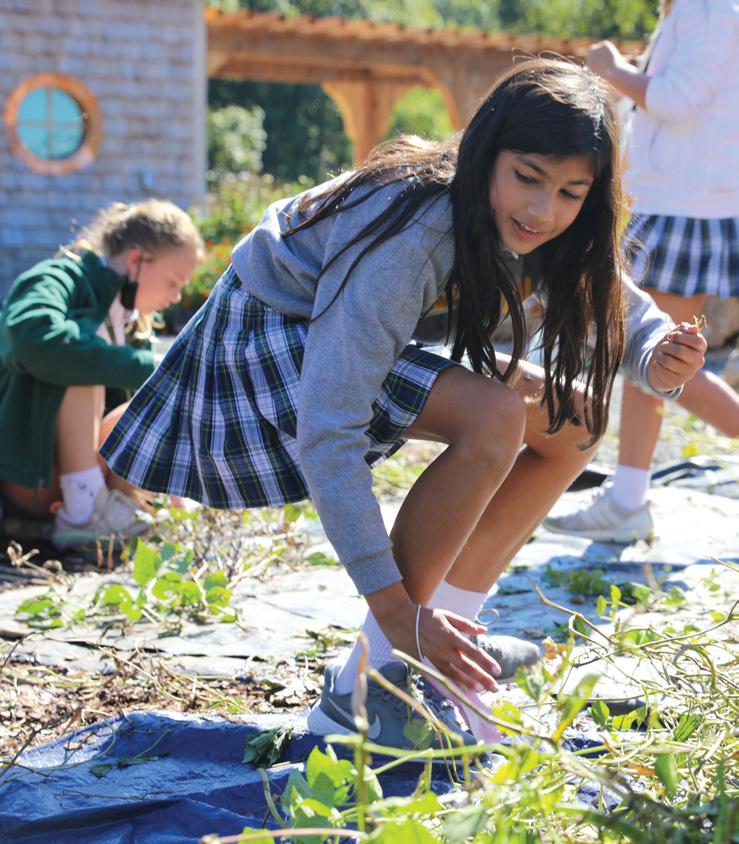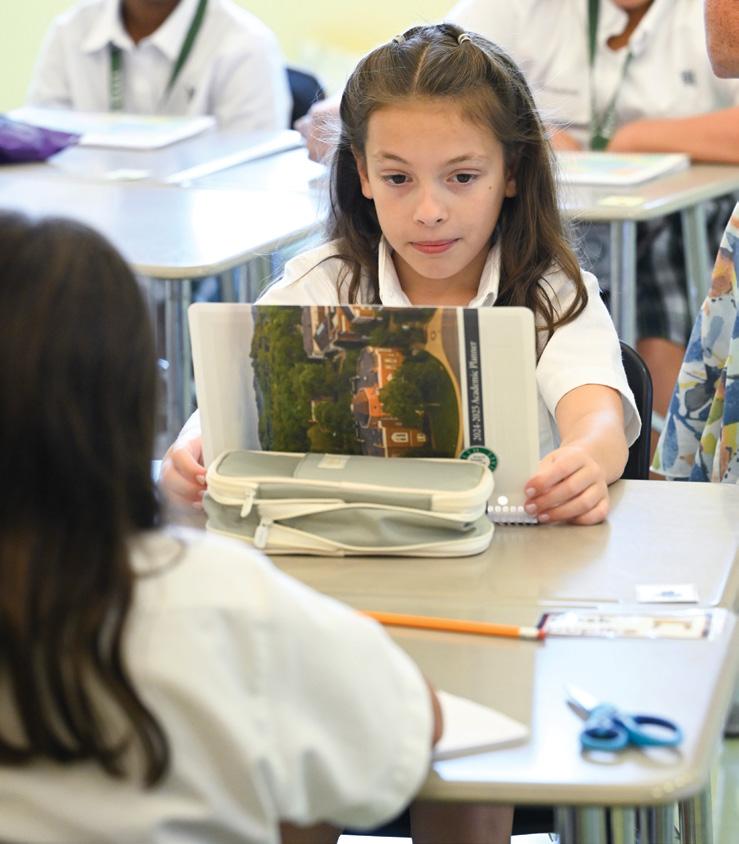






MISSION STATEMENT
Harpeth Hall educates girls and young women to think critically, lead confidently, and live honorably.
Our core purpose is to nurture a sense of wonder, to instill a will and facility for learning, and to promote cultural understanding, environmental stewardship, and service to others. The pursuit of these goals will inspire students and faculty to combine knowledge with goodness and reflection with action.
VALUES STATEMENT
Harpeth Hall’s values are the foundation of our school community.
• We build resilience, empowering our girls to be confident in their beliefs and abilities.
• Integrity and honor guide every decision and action.
• We celebrate intellectual curiosity and creativity, encouraging a lifelong pursuit of knowledge and understanding.
• Kindness and respect enrich our interactions and strengthen the bonds within our community. Together, we uphold these values, building a community where every individual feels supported and inspired by our educational mission.
At Harpeth Hall, we believe in the dignity, power, and potential of every girl. We foster an inclusive environment where students can achieve the highest level of learning and understanding. We are confident that diverse school experiences enrich individuals with deeper understandings of themselves and others. We take seriously our obligation to cultivate a strong sense of community so that all students, faculty, and families feel connected and belong at Harpeth Hall.

Here at Harpeth Hall, girls lead in everything we do. Girls take center stage in all theatre productions and concerts. The president of every club and the captain of every team is a girl. And it’s girls who are the first to raise their hands in class to answer a question or share an insight. In the Daugh W. Smith Middle School at Harpeth Hall, our students are presented with challenges and opportunities of all kinds, a hallmark of the Harpeth Hall experience and one that we know is particularly important for adolescents. The starting point for these challenges and opportunities is the academic program.
Other than the first 18 months of life, the middle grade years bring the most significant growth, including social and emotional maturation, cognitive development, and physical change. Harpeth Hall’s middle school curriculum encompasses every aspect of a girl’s educational program, providing ample opportunity to explore and develop deep skill in academics, arts, physical education, life balance, leadership, athletics, and community service.
Our middle school girls learn the foundational skills and content that are essential to becoming critical thinkers, honorable and responsible citizens, and confident leaders in any setting. The thoughtfully scaffolded curriculum embeds this skill development into classes, advisory, study hall, and even extra help. The middle school program is strategically designed to build year over year, from 5th grade through 8th grade.
In the middle school academic program, we are deliberate about what is being taught, why it is being taught, and when it is being taught. Our exceptional middle school teachers at Harpeth Hall deeply understand and appreciate this developmental phase, regularly engaging in ongoing professional learning to ensure they know the best ways to teach and support middle schoolers, but specifically middle school girls. Some of these strategies include project-based learning and varied assessments that incorporate student choice. Time for reflection on learning — or metacognition — is also embedded into the girls’ classroom experiences.
Every element of the middle school program is intentionally designed to complement and support the academic program and the students’ development and growth. From the daily schedule, which incorporates a balance of academic time with non-academic time and offers a pace that allows for extra help and reflection between academic classes, to the physical layout of the building, which facilitates community among the girls, ensures multiple caring adults have eyes on them, and fosters executive functioning skills, the Daugh W. Smith Middle School truly is a place where the minds and spirits of our girls are lifted up.
Sincerely,
Elizabeth Townsend Ecker ’00
English
• Geography • Mathematics • Science
• Chinese, French, Spanish
• Art, Theatre, Orchestra, Chorus
• Physical Education/ Dance • Life Balance
GRADE
GRADE
English
• Ancient History • Mathematics • Science
• Chinese, French, Spanish
• Art, Theatre, Orchestra, Chorus
• Physical Education/ Dance
• Life Balance
English
• American History • Pre-algebra, Accelerated Pre-algebra
• Science
• Chinese, French, Latin, Spanish
• Art, Public Speaking, Chorus, Orchestra, and Music and Culture (MAC)
• Physical Education/ Dance
• Life Balance
English
• U.S. and the World in the 20th Century
• Algebra I, Accelerated Algebra I
• Science
• Chinese, French, Latin, Spanish
• Art, Theatre, Chorus, Orchestra, and Music and Culture (MAC)
• Physical Education/ Dance
• Life Balance
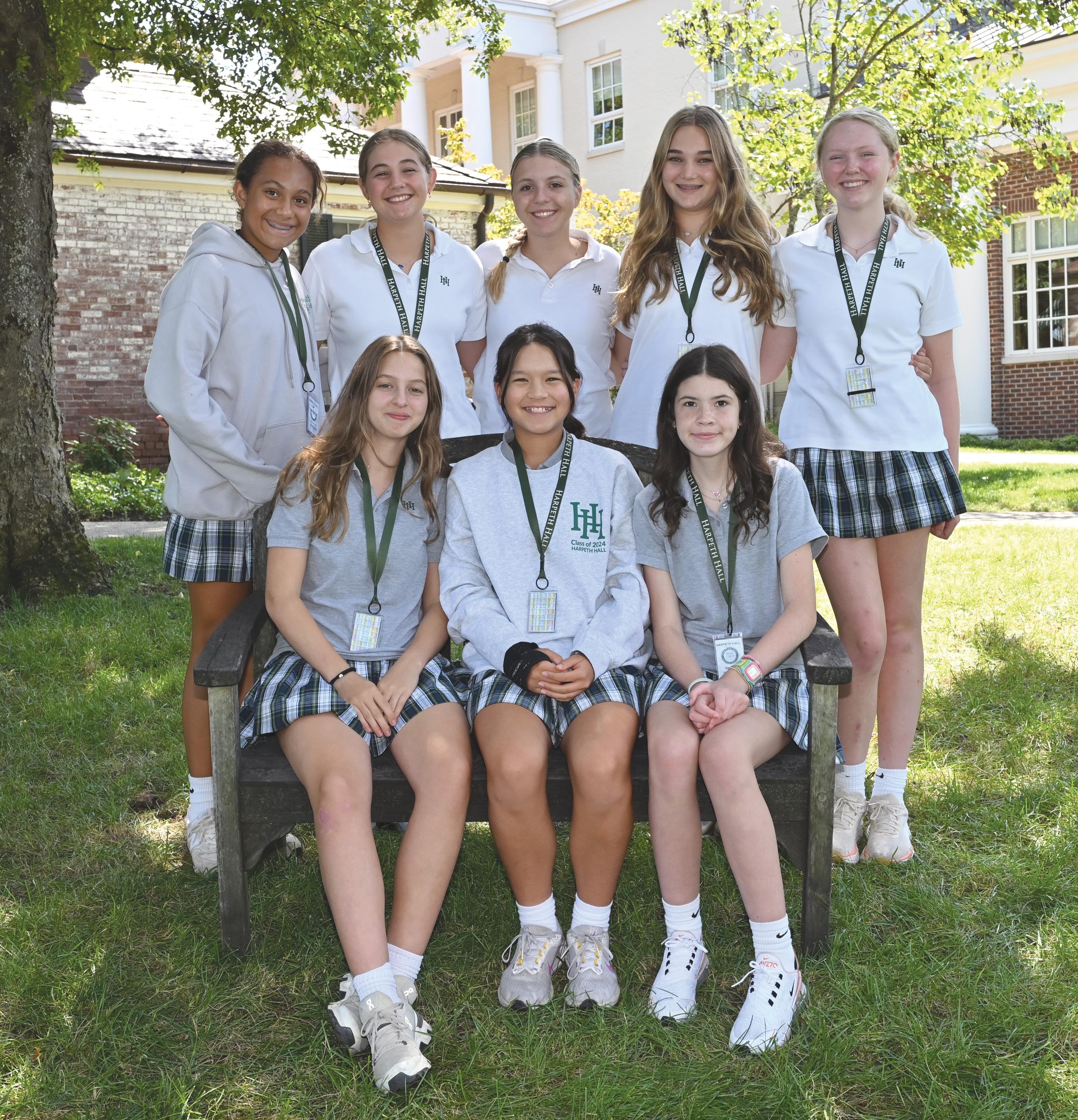
In a seven-day rotation in 5th grade, each student attends . . .
• English class six times.
• math, science, and social studies classes four times.
• world language class twice.
• theatre and visual art classes twice, for one semester each.
• music class twice.
• dance class once.
• physical education class twice.
• Life Balance class once.
In a seven-day rotation in 7th grade, each student attends . . .
• English, math, science, and social studies classes four times.
• music or visual arts class twice, depending on student choice.
• speech / theatre, visual arts, or Music and Culture twice, for one semester each, depending on student choice.
• dance class once.
• physical education class twice.
• Life Balance class once.
In a seven-day rotation in 6th grade, each student attends . . .
• English class six times.
• math, science, and social studies classes four times.
• world language class twice.
• theatre and visual art classes twice, for one semester each.
• music class twice.
• dance class once.
• physical education class twice.
• Life Balance class once.
In a seven-day rotation in 8th grade, each student attends . . .
• English, math, science, and social studies classes four times.
• music or visual arts class twice depending on student choice.
• theatre, Music and Culture, or visual arts for one semester each, depending on student choice.
• dance class once.
• physical education class twice.
• Life Balance class once.
All middle school students take classes in music, visual art, dance, and theatre. Dance is one of the three components of the Wellness block.
Students in 5th and 6th grades take the following arts courses:
• a year-long course in chorus or orchestra, plus one semester each of theatre and visual art
Students in 7th grade have the choice to take one of the following arrangements for their fine arts requirement:
• a year-long course in chorus or orchestra, plus one semester each of theatre and visual art
• a year-long course in visual art, plus one semester each of Music and Culture and theatre
Students in 8th grade have the choice to take one of the following arrangements for their fine arts requirement:
• a year-long course in chorus or orchestra, plus a year-long course in visual art
• a year-long course in chorus or orchestra, plus one semester each of theatre and visual art
• a year-long course in visual art, plus one semester each of theatre and Music and Culture
All middle school students take a world language course. Middle school students select one language for 5th and 6th grades. Students have the option to select a new language for 7th and 8th grades or continue with the same language for all four years in middle school.
5th and 6th grade students may select Chinese, French, or Spanish.
7th and 8th grade students may select Chinese, French, Latin, or Spanish.
The middle school English program lays the foundation for students to read, write, and speak well. In addition to these primary goals, we build a comfortable and open community for girls to explore and share ideas and opinions. The curriculum includes the analysis of literature, the study of grammar and usage, vocabulary, spelling, and the development of writing skills across multiple genres. At their core, these activities foster each girl’s love of reading, intellectual fortitude, and writer’s voice.
The 5th grade English program harnesses the energy and enthusiasm girls bring for reading and writing and begins to apply the disciplines of argumentation. Students practice providing textual support for their opinions about a book, considering others’ viewpoints in the discussion, and presenting their ideas with precise language and usage, especially at the sentence level. To accomplish these goals, students read international folk tales, historical fiction, realistic fiction, a collection of books around the theme of discrimination, and a novel written in verse. As they collaborate with their peers and receive daily feedback from their teachers, their confidence in English grows.
5th grade English texts include the following:
• The New Reader as Detective by Burton Goodman
• Serafina’s Promise by Ann E. Burg
• Tatterhood Tales edited by Ethel Johnson Phelps
• Walk Two Moons by Sharon Creech
• The Watsons Go to Birmingham by Christopher Paul Curtis
• Student choice of either Maniac Magee by Jerry Spinelli, Counting on Grace by Elizabeth Winthrop, Out of My Mind by Sharon Draper, Bud not Buddy by Christopher Paul Curtis, or Front Desk by Kelly Yang
The 6th grade English curriculum further develops students’ critical reading and writing skills through the study and discussion of class texts. These texts serve as the basis for a deep practice of the writing process as students explore their ideas in brainstorming, drafting, and revising creative and expository pieces. The grammar focus in 6th grade builds on the foundation laid in the 5th grade, reviewing the concepts of parts of speech, parts of the sentence, and usage while working with more complex sentences. The year culminates in an individual project called “Distinguished Women.” Each girl selects one distinguished woman from history to research and personify in an original spoken-word biographical poem. This project incorporates all skills acquired throughout the year, including reading, writing, and speaking.
6th grade English texts include the following:
• D’Aulaire’s Book of Greek Myths
• The Outsiders by S.E. Hinton
• The Girl Who Drank the Moon by Kelly Barnhill
• Student choice of either Brown Girl Dreaming by Jacqueline Woodson, Red, White, and Whole by Rajani LaRocca, Inside Out and Back Again by Thanaha Lại, or Macy McMillan and the Rainbow Goddess by Shari Green
The 7th grade English curriculum forms the class into a cohesive community as students acquire foundational grammar and vocabulary knowledge and practice academic reading and writing skills. Girls are empowered to express their voices in complex ways as they learn how the study of grammar can help them put their thoughts into words more precisely and completely. Seventh grade literature selections promote girls’ global awareness and independent thinking as they encounter multiple genres and voices. Using these rich literary works as a springboard, girls become more sophisticated in utilizing textual evidence to support their claims in academic writing and through the give-and-take of structured class discussions. Confident in their preparation, girls depart 7th grade as proficient writers, readers, and thinkers.
7th grade English texts include the following:
• Anne Frank’s Diary of a Young Girl
• Chains by Laurie Halse Anderson
• The Giver by Lois Lowry
The 8th grade English curriculum focuses on the analysis of literature, the study of grammar in its most complex forms, the process of writing, and the acquisition of vocabulary. Students think about the value of the humanities in understanding the world and their place in it, applying lessons from what they read to their own lives and current issues. In every discussion and writing assignment, students critique their ideas, evaluating the logic and textual evidence they use to form their opinions. Students write often and in varied forms, including handwritten journals in class, electronic discussion board posts, poetry, personal essays, and formal literary analysis. Eighth grade students leave middle school as sophisticated, confident thinkers and writers.
Eighth grade English texts include the following::
• To Kill a Mockingbird by Harper Lee
• Lord of the Flies by William Golding
• Romeo and Juliet by William Shakespeare

The social studies program in middle school equips students with the skills necessary to think like historians and engage as informed citizens. Through a study of geography, history, civics, and current issues, each student learns to listen to the ideas of others as she shapes and clearly expresses her own. Throughout the middle school experience, each student gains a foundational awareness of complex global connections and the knowledge that her actions can, and should, make a positive change in her world.
The 5th grade world geography curriculum develops an understanding and a sense of curiosity for different places, environments, and cultures. Students begin their journey by observing the Earth as geographers, learning how to read and interpret information from various types of maps, as well as creating maps of their own. In the first semester, research and communication skills are introduced in a project during which students use evidence to decide whether or not they could survive in a specific biome. During the spring semester, students gain a foundational understanding of the relationship between geography and various political, cultural, and economic systems. Students learn about citizenship, how a market economy functions, and how geography has influenced cultures around the world.
Building upon the geographical and cultural foundation of the 5th grade curriculum, 6th graders explore the history and social structures of ancient civilizations. The year begins with an introduction to historical thinking, as students learn to evaluate artifacts and create workable hypotheses. The study of each new civilization is tied to a specific theme such as power and propaganda or government and philosophy, and students develop their research, note taking, discussion, and group work skills through engaging simulations and projects. The year culminates with an interdisciplinary study of the mythology and history of ancient Greece, as students complete quests inspired by Greek values such as justice, wisdom, and ingenuity.
Seventh grade students explore the growth of the United States and its civic institutions from the nation’s beginnings to its imperfect recovery following the Civil War. Throughout the year, students work to understand U.S. government structures, recognize the connection between current political debates and debates of the past, and explore the connection between the choices people made and the values they prioritized. Students build on the historical thinking skills developed in 6th grade as they consider more complex research topics that incorporate varied and conflicting points of view and extend their nonfiction reading and writing skills.
The 8th grade social studies curriculum considers the complex development of the United States in the 20th century and today. Students develop an understanding of the relationship between the government and the economy, social interactions and how groups of people challenge injustice, and global interactions and conflicts. This study offers historical context to contemporary events and broadens understanding of the past and present. In the second semester, students apply research, collaboration, and public speaking skills in various projects throughout the year.
Our mathematics curriculum builds foundational problem-solving, number sense, and procedural fluency skills with increased complexity across grades. Math faculty emphasize deep understanding and application while incorporating group work, discovery, and class discussions into lessons. By prioritizing experience and conversation before formalization, students make sense of their solutions and apply them to the real world. As they progress through our program, students gain confidence and the necessary skill set to continue their math journeys successfully.
The 5th grade course is designed to transition students from diverse elementary backgrounds and prepare them for success in our middle school mathematics program. The primary skills taught in this course are visualizing, estimating, and solving multi-step problems. Throughout the year, students explore the properties of numbers and how operations create relationships between whole numbers, fractions, and decimals. Through small group work, exploration, and discussion, students explore and problem solve. Students also learn how and when to use visual representations, deduction, and algebraic reasoning for real-world problem-solving. Students are exposed to topics that they will build upon in 6th grade such as rational numbers and ratios.
Mathematics in the 6th grade is a bridge from arithmetic to applying algebraic problem-solving strategies. The course is designed with the real world in mind, encouraging students to recognize that math is all around them. The big ideas in 6th grade are: ratios and rates, integer operations, expressions, and expression applications. Estimation, mental math strategies, number sense, and reasoning skills are woven throughout these content strands. In this course, students are encouraged to use visual representations to explore big math concepts and use those as tools to access standard algorithms. In each class, students engage in small group problem solving, fluency exercises, and reflection.
7th Grade
Pre-Algebra
The 7th grade pre-algebra course allows students to extend their foundation in problem-solving, proportional reasoning, and rational number operations to explore more abstractly the patterns and relationships mathematics uncovers. Students further expand their use of variables in writing and evaluating expressions. After learning to reason with equivalence, students learn the principles of solving complex equations and inequalities in the context of geometrical explorations of angles and two-dimensional shapes. Additional topics include 3-D geometry, percent equations, and statistics and probability. A stock market project to enhance financial literacy rounds out this robust curriculum.
This 7th-grade course is fast-paced, encompassing the curriculum of a standard pre-algebra course along with several foundational topics from Algebra I. The focus is on fostering student-led discovery and honing problem-solving skills. Real-world applications include the Stock Market project, the linear art project, and the Cereal Box Contest. Throughout the course, technology is integrated to enable students to delve into mathematical concepts within real-world scenarios, facilitating a dynamic and engaging learning experience. This course is the first part of a two-year accelerated Algebra track.
8th Grade Algebra I
The Algebra I course is designed to instill a deep understanding of algebraic structure and thinking. The main topics covered include linear equations and inequalities, systems of linear equations, laws of exponents, operations with polynomials, and quadratic equations. Emphasis is placed on graphing and deriving equations of lines, solving systems of equations, and operations with and factoring of polynomials. Through collaborative group work, students explore concepts, identify connections, and articulate their reasoning. Throughout the course, students continue to develop problem-solving skills and mathematical fluency and discover patterns that will prepare them for higher-level math courses.
This course constitutes the second segment of the accelerated algebra sequence, transitioning from studying linear equations to exploring quadratic concepts. Emphasis is placed on mastering the skill of factoring quadratics, which serves as a foundational tool for simplifying and solving more intricate quadratic expressions and equations. Beyond comprehensive coverage of quadratic principles, this course introduces Algebra II topics such as quadratic functions, absolute value inequalities, and radical expressions. Students delve into all topics with thoroughness and at an accelerated pace. The curriculum underscores the development of self-directed exploration, problem-solving abilities, analytical thinking, and logical reasoning. Successful completion of this course equips students with the necessary skills for advancement to Honors Geometry in 9th grade.

The middle school science program is designed to encourage wonder and teach scientific skills. Through experiment-based inquiry and the engineering design process, students explore a broad range of topics within the earth, life, chemical, computer, and physical sciences. Emphasis is placed on helping students make meaningful connections between the material learned in class and the world around them. This program prepares students for future science courses and promotes confidence in experimental design, a spirit of curiosity, and a disciplined approach to inquiry and research.
In 5th grade science, students are encouraged to wonder about the natural world, beginning with a focus on measuring and describing the matter that makes up the world around them. In the fall, students learn to sketch with the eye of a scientist and identify the structures of leaves as the leaves on campus change colors. Students then examine how Earth’s dynamic systems are connected through the transformation of energy and cycling of matter. Students combine their creativity with science knowledge to design and present potential carbon dioxide capture devices. Through an exploration of ecosystems and ecology, 5th grade science students engage in the garden and look at the living organisms on Harpeth Hall’s campus through an ecological lens. With their new knowledge and skills, 5th grade science students are then ready to explore space. The course culminates in a collaborative project in which students apply what they have learned about Earth’s cycles and systems to design a colony sustaining life on Mars.
Using the characteristics of life as a framework, 6th grade science students explore what it means to be a living thing. Throughout the year, students discover and describe the living world through inquiry, observation, and experimental design. From cells to complex organisms, students examine how structures impact functions and how matter and energy are transformed to allow those structures and functions to exist. Students gain an understanding of the specialization of cells, which allows them to discover how systems work within an organism and how these systems interact with each other to maintain homeostasis. The year ends with a field study of life in our school garden. Students apply their understanding of living things to explore the intricate interactions between plants and animals.
This physical science course focuses on energy in all its forms within an engineering design framework. Students apply their knowledge through many engineering projects, including building bridges after understanding forces, motion, and computer modeling; designing a roller coaster that demonstrates energy transformations; and designing an insulating sleeve for a cup of hot cocoa after learning about thermal energy. Additional topics covered include energy production, Earth’s climate, sound, and light. A unit on robotics using Lego Spike products solidifies the engineering principles emphasized all year. Throughout the curriculum, opportunities abound for students to gain confidence in innovation and problem-solving with our unique approach to combining science content with engaging and relevant engineering designs.
The 8th-grade curriculum builds on scientific concepts and the engineering design process, focusing on matter and how the very small can lead to big things. With an emphasis on experimental design, students explore the properties of matter, atomic theory, and chemistry. Projects include designing a submarine based on the property of density, using forensic techniques and knowledge of chemical and physical properties to analyze a “crime scene,” and independent research on the chemistry and the brain. In addition, authentic computer-programming experiences are incorporated throughout the course as students apply their scientific understanding to real-world issues. Through project-based learning, the curriculum allows for collaboration, critical thinking, and scientific communication.
The middle school language program provides the opportunity to acquire a foundation in one or two world languages and foster an understanding of local and global cultures. The curriculum develops listening, reading, speaking, and writing skills by using the target language as often as possible and reading, viewing, and analyzing resources from a variety of cultures. Ultimately, students develop communication skills, cultural awareness, and empathy.
Students begin their world language study in the 5th and 6th grades through Chinese, French, or Spanish. At the end of 6th grade, students select a world language and study this language as one of their core academic classes in the 7th and 8th grades. They may continue in the same language as 5th and 6th grades or choose a different language (Chinese, French, Spanish, or Latin).
5th and 6th Grade Language
In 5th and 6th grades, students take a foundational course in a world language of their choice (Chinese, French, or Spanish). This world language class meets twice a seven-day rotation. The program enables students to acquire basic listening, reading, speaking, and cultural awareness skills through stories, songs, games, conversations, and cultural exploration. Please note, this is an entry-level program for students with little to no prior exposure to the language. If your child has sizable previous exposure to a language, you may consider enrolling her in a different language in 5th and 6th grade. At the end of 6th grade, students select a world language and will study this language as one of their core academic classes in the 7th and 8th grades.
7th and 8th Grade Language
Chinese
In 7th and 8th grades, students take a beginning Chinese course equivalent to one year of high school Chinese. This comprehensive program emphasizes Pinyin, Chinese characters, and pronunciation tones, refining speaking and listening skills. Rigorous character reading and writing practice develop fundamental vocabulary and basic sentence structures. Discussions about family, personal interests, and daily life are facilitated using the language. Additionally, students conduct introductory research on Mandarin-speaking countries, exploring aspects such as land, people, environment, and traditions. This holistic approach fosters a nuanced understanding of diverse cultures and values, enriching their language education with a well-rounded perspective on Mandarin and its cultural contexts.
French
In 7th and 8th grades, students take a beginning French course equivalent to one year of high school French. This course aims to enable students to communicate effectively on a variety of familiar topics (home, school, food, leisure activities, etc.) and to make simple but meaningful comparisons between their own cultures and a variety of Francophone cultures. To this end, French is used in the classroom as much as possible, providing opportunities to listen, read, and interact with speakers across the Francophone world. Emphasis is placed on proficiency and communication in a variety of everyday contexts. Throughout the course, students are introduced to the diversity of the Francophone world, with a focus on contemporary culture. An optional multi-day trip to Quebec is available to 8th grade students at the end of the school year.
In 7th and 8th grades, students take a beginning Latin course equivalent to one year of high school Latin. Using the Cambridge Latin Course, students follow the adventures of a Roman family as they learn grammar and vocabulary through reading. In addition, students learn about the Latin roots of English vocabulary and are exposed to basic linguistic principles applicable to many languages. Students read stories, investigate topics on Roman history, mythology, and culture, and are introduced to classical influences on art, architecture, government, and literature
Spanish
In 7th and 8th grades, students take a beginning Spanish course equivalent to one year of high school Spanish. This course aims to enable the student to communicate with native speakers, and to this end, the class is conducted in Spanish as much as possible. The class emphasizes the language’s oral, aural, written, and spoken attributes, which are cornerstones of language proficiency. While students improve linguistic proficiency, they also gain cultural appreciation by studying Spanish-speaking countries. Activities include conversational Spanish, short readings, written compositions, cultural projects, and Spanish music genres. An optional multi-day trip to Costa Rica is available to 8th grade students at the end of the school year.
The middle school visual arts program stimulates and encourages creativity, builds confidence in technical abilities, and provides students with a solid foundation in the elements and principles of art. Students develop skills in each medium through age-appropriate projects that build upon what students have learned in the previous years as they advance from 5th through 8th grades. The halls of the middle school continually display student artwork. All students keep sketchbooks to develop artistic habits of continual practice and experience a variety of media. Middle school artists are encouraged to explore, make decisions, take risks, and think critically.
Fifth-grade art focuses on developing the students’ natural creative abilities and instilling the belief that, with patience and practice, everyone can learn to see and create good art. Art vocabulary is introduced and practiced with projects that teach about line, shape, color, form, and texture. Students work in various mediums, including drawing, painting, printmaking, collage, sculpture, and textiles.
Sixth-grade art builds upon skills learned in 5th grade, and projects expand to encompass more complex concepts and skills. Students hone their technical competency through more lengthy and involved drawing, printmaking, painting, and sculpture projects. Projects are technically rigorous and designed to challenge varying levels of ability. Experimentation is highly encouraged, and students are expected to push the boundaries of their creativity.
Students gain sensitivity in drawing from careful observation and learning how parts come together to form a whole. Experiences in three-dimensional and two-dimensional art continue to build, including creating spatial depth and using value to shade realistically. The yearlong option encourages students to delve deeper into how image selection and placement can relay personal messages.
Eighth-grade students continue to develop their technical skills in a series of exploratory exercises, resulting in smaller projects using various media. The 8th-grade focus is learning to think conceptually and how to translate those thoughts into visual imagery. The yearlong option for 8th grade goes into greater depth and allows time for some experimental work and personal self-expression.
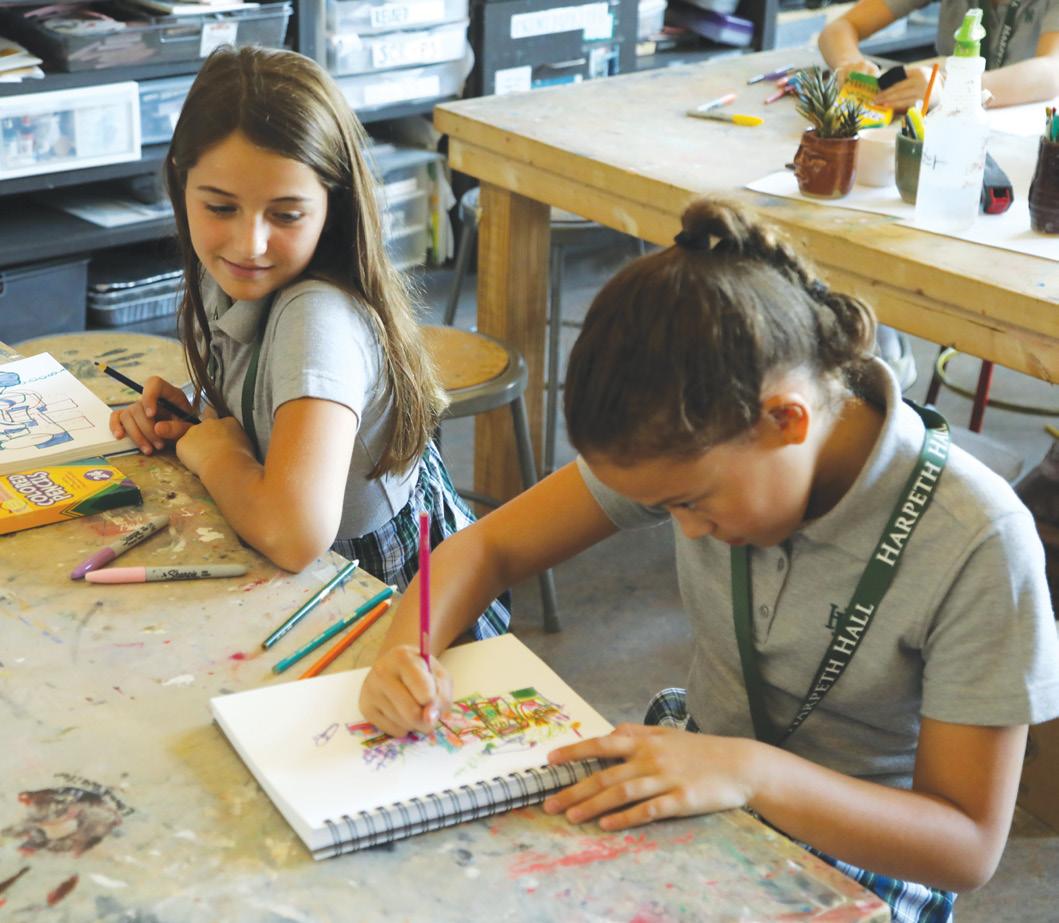

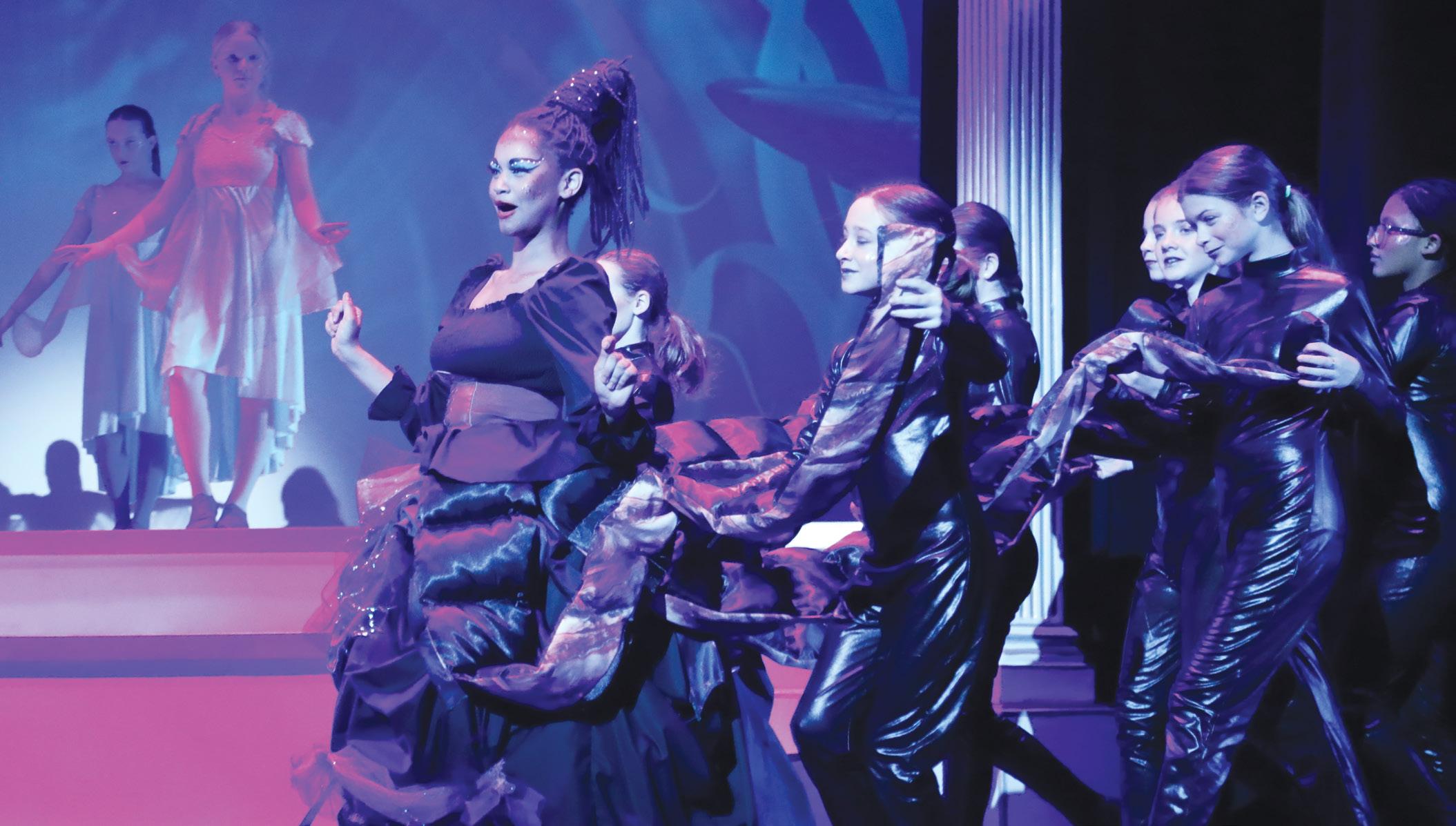



Middle school theatre and speech courses allow students to explore essential communication and presentation skills. Coursework provides opportunities to more fully understand different modes of self-expression related to public speaking and drama in an environment where the student feels challenged yet safe and encouraged. Classes provide a forum for presentations, discussions, and peer critiques to broaden the students’ intellectual understanding and appreciation of the art form involved.
Students participate in creativity exercises incorporating specific elements of the performing arts to which they add their own imaginative inventions of movement, characters, and plots. Students in 5th grade learn classic illusion mime techniques that they demonstrate through original character sketches, creative writing, and short skits presented to their classmates.
Students participate in advanced creative theatre exercises about life experiences set in historical contexts. They participate in activities and recreate scenes from Greek mythology through role-playing and playwriting exercises. Students also learn to recognize the elements of comedy that have been prevalent in Western theatre from the times of the ancient Romans through improvisation, playwriting, and presentation of class projects.
Seventh grade students participate in a variety of speech projects, giving them several opportunities to prepare formal and informal presentations in front of an audience. Practical experience, imaginative vocal interpretation, and paradigms for entertaining, informative, and persuasive public speaking projects are introduced. All projects emphasize poise and self-confidence, as well as the importance of critical listening skills and peer support.
Eighth grade students survey various theatrical arts components through individual study and collaborative projects. Using selected works of William Shakespeare as a guide, this course introduces students to acting techniques, stage terminology, theatre genres, character analysis, and scene presentation. Activities and projects encourage eye contact, collaboration, critical thinking, listening, synthesis, and application, along with creativity, concentration, and self-expression in defined formats and ensemble work.

Middle school dance covers creative movement, modern, ballet, jazz, and other dance techniques. We aim to provide an environment that helps the student become comfortable with movement in a wide range of dance styles. The outcome for each student is to understand the basic forms of dance technique, allow individual expression through the art form, and help explore movement through music and self-expression. These courses can spark students’ desire to pursue dance and continue their interest in learning the valuable lessons dance offers in everyday life.
Creative movement and basic dance technique are introduced in the first semester. Choreographed dances also incorporate jazz and contemporary, allowing the students to begin work with popular forms of movement. The goal of the class is to allow each student to work in a structured, creative environment and understand the pleasures and benefits that dance offers. Each student develops a basic vocabulary, builds a movement base, and learns choreographed combinations from various disciplines and dance styles.
Using creative movement, modern and ballet techniques are reviewed and expanded. Linking steps, jumps, and turns are covered with a continuing emphasis on terminology. Jazz is introduced as a technique focusing on isolations, rhythm, and motor coordination. The goals of this class are to allow the student to work in a structured, reassuring environment at an individual pace and understand the value of dance as an exercise and as an art form. Each student will develop more confidence and freedom with a kinesthetic awareness while building a broader base of movement and vocabulary in multiple genres.
Dance students in 7th grade establish a more in-depth understanding of dance history and appreciation. Dance terminology is utilized at an intermediate level. Students work individually and in groups using center work and movement across the floor, as well as improvisation and collaboration to master choreographed sequences. Students are allowed to progress at an individual pace while maintaining the basic group structure. The goal of this class is for each student to work in a nurturing environment, acquire and utilize intermediate dance terminology, develop the rhythmic and kinesthetic awareness that dance supports, and appreciate and better understand dance as a performing art form.
Eighth grade students continue to progress from their prior years’ experience by learning and developing a deeper understanding of the importance of classic jazz movements, contemporary, ballet, and other dance forms. Emphasis is placed on movement vocabulary to understand how cultures combine to influence dance. Students work individually and in groups on creative solutions in choreography and improvisation using character study, movement, pantomime, abstraction, and analysis. They also learn and present prepared combinations to further their understanding of performing.





Music courses in the middle school give students a broad experience in both choral and orchestral music as well as a survey of music history and music theory. The primary focus is acquiring techniques that will enhance students’ performance skills and prepare them for upper school ensembles. The program includes music from a variety of cultures.
Fifth grade students begin to work toward musical literacy through the systematic study of a string instrument. Students learn basic musical notation while developing instrumental technique. Students may choose to play the violin, viola, or cello. There are no prerequisites to participate in 5th grade orchestra, and students who already play the violin, viola, or cello are encouraged to participate in the orchestra. Students may have an opportunity to start string bass after completing at least one year on the cello and upon approval of the director.
Sixth grade orchestra is designed for students who wish to continue their study of a string instrument. Beginners may participate in the 6th grade orchestra with prior approval from the instructor. In the 6th grade, orchestra students continue to develop technique on their chosen instrument while gaining an even greater knowledge of the concepts of rhythm, pitch, melody, harmony, and tone.
String students in the 7th grade build on the basics through advanced string techniques and continue to fine-tune basic musical skills. This is accomplished through the use of literature and music that is appropriate for developing basic musical concepts and skill levels. One or more years playing a traditional string instrument or director’s approval is required. String students entering the 7th grade are eligible to participate in the middle school advanced orchestra.
String students entering the 8th grade orchestra grow in their understanding of advanced string techniques, including vibrato, shifting, and improvisation. Students continue to advance their skills while working on appropriate ensemble literature. A prerequisite for this class is 7th grade orchestra. Students in this class are also eligible to participate in the middle school advanced orchestra.
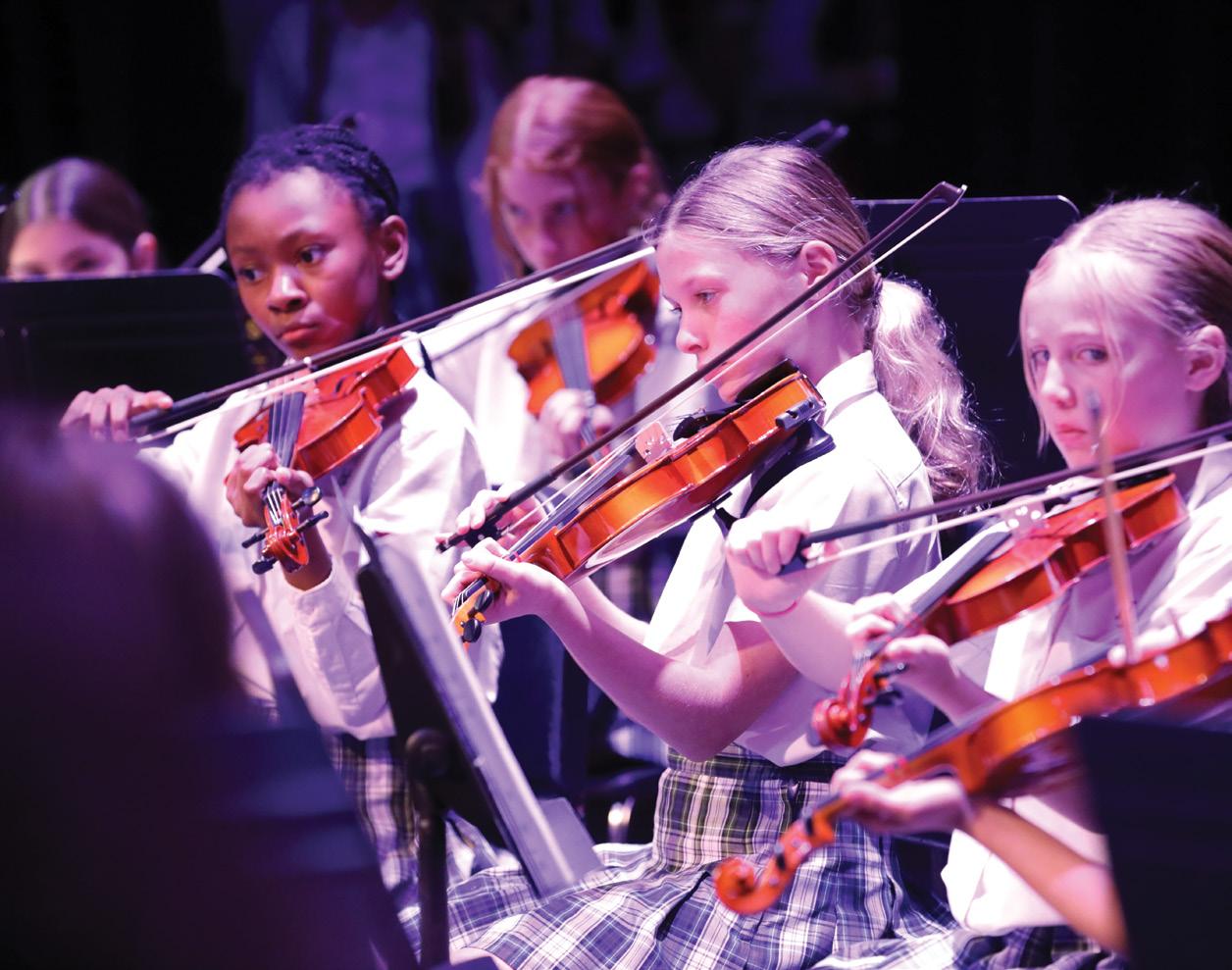

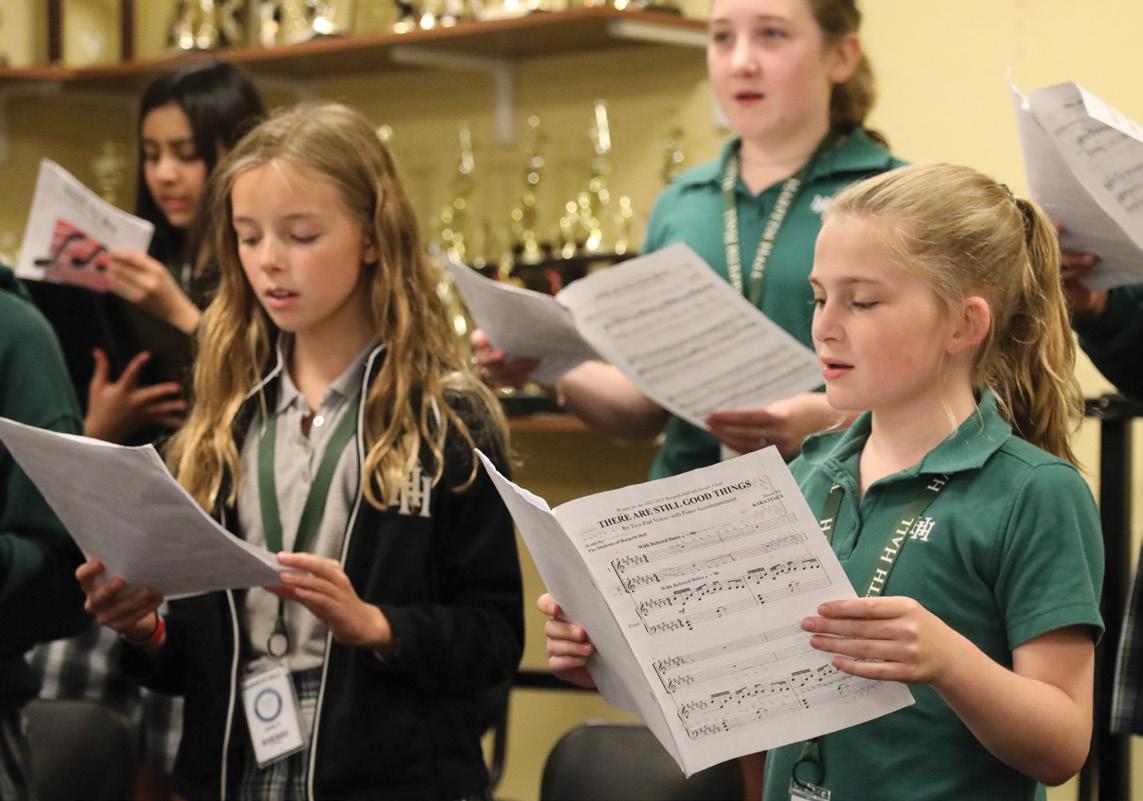

5th Grade
Fifth grade students explore a general music curriculum that includes developing the concepts of rhythm, pitch, melody, harmony, and tone. They work toward music literacy by developing a knowledge of basic notation, articulations, and dynamic markings and the ability to sight-sing. Students sing in unison and two parts and also learn the basics of beautiful choral singing, including vocal tone, breathing, and diction.
6th Grade
In 6th grade chorus, students continue to work on proper vocal technique and sing choral literature from a variety of periods and styles. They continue to expand their knowledge of notation, articulations, and dynamic markings. In addition, students work to sustain and develop their sight-reading and aural skills.
7th Grade
In the 7th grade chorus, students focus on learning the fundamentals of music literacy, with emphasis on moveable-do solfège, and Takadimi rhythm-reading. Students also work on vocal technique fundamentals, including strengthening their head voice (upper range) and working towards singing in three-part harmony while singing in a variety of styles and languages.
8th Grade
In the 8th grade chorus, students sing in two- and three-part harmonies, focusing on advanced choral technique such as vowel modification, resonance, dynamics, and non-traditional notation. They also focus on applying music literacy through sectionals and sightreading. The 8th grade choir often collaborates with the upper school choirs.
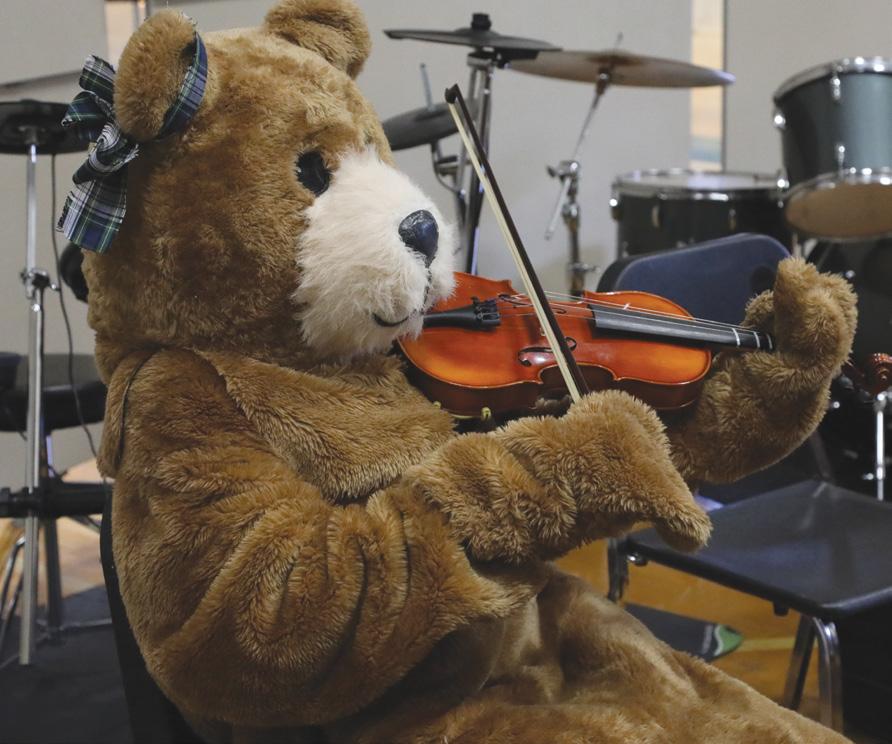
7th Grade
Students taking 7th grade Music and Culture will study a broad spectrum of music. This class provides a general overview of musical notation, genres, history, composition, and instruments. Students will practice and apply these music skills using instruments and the performing arts lab.
8th Grade
Students taking 8th grade Music and Culture will expand their knowledge of musical notation, history, instruments, and composition. They may practice and apply these skills using instruments and the performing arts lab.
The middle school physical education program promotes the importance of lifetime fitness and physical activity as an essential component of overall physical and mental health. Students will learn how to work with a team, practice good sportsmanship, and demonstrate respect for one’s self and others while participating in games and sports. The program is designed for every student to find a love of physical activity by introducing students to a variety of activities and sports that focus on movement and fitness.
By exploring a variety of activities and sports, 5th and 6th grade students focus on gross motor skills and core fitness movements with an emphasis on teamwork and sportsmanship. Skill areas include striking, dribbling, throwing, catching, and kicking. Students develop these skills by playing games and sports such as volleyball, Omnikin, kickball, and soccer. The tumbling unit in both grades helps students develop strength and fine motor skills and brings out their creative side when each student designs her own routine. The cross-curricular Olympics unit is a favorite among the students, as they compete for gold in various events with students from all grade levels.
In 7th and 8th grade, students focus on lifetime sports and fitness. Students learn more about individual fitness, emphasizing proper technique while performing core fitness movements. Students practice these movements and techniques during the weight room orientation unit and fitness days throughout the year. Students also learn how to play lifetime sports such as golf, tennis, pickleball, badminton, spike ball, and ultimate frisbee while emphasizing strategy and leadership skills. Tumbling returns in 7th grade, and the annual Olympics unit across all grade levels continues to create community connections and fun.

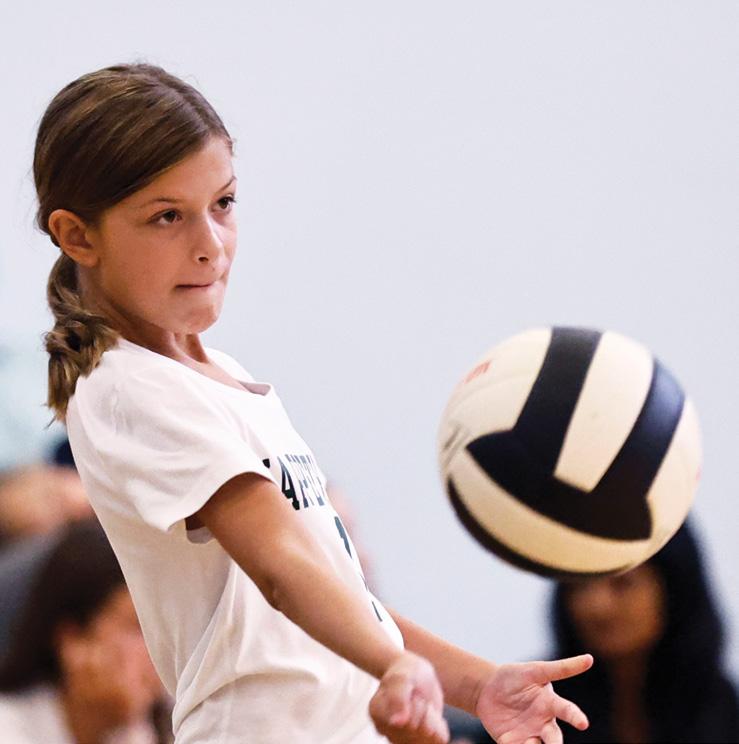


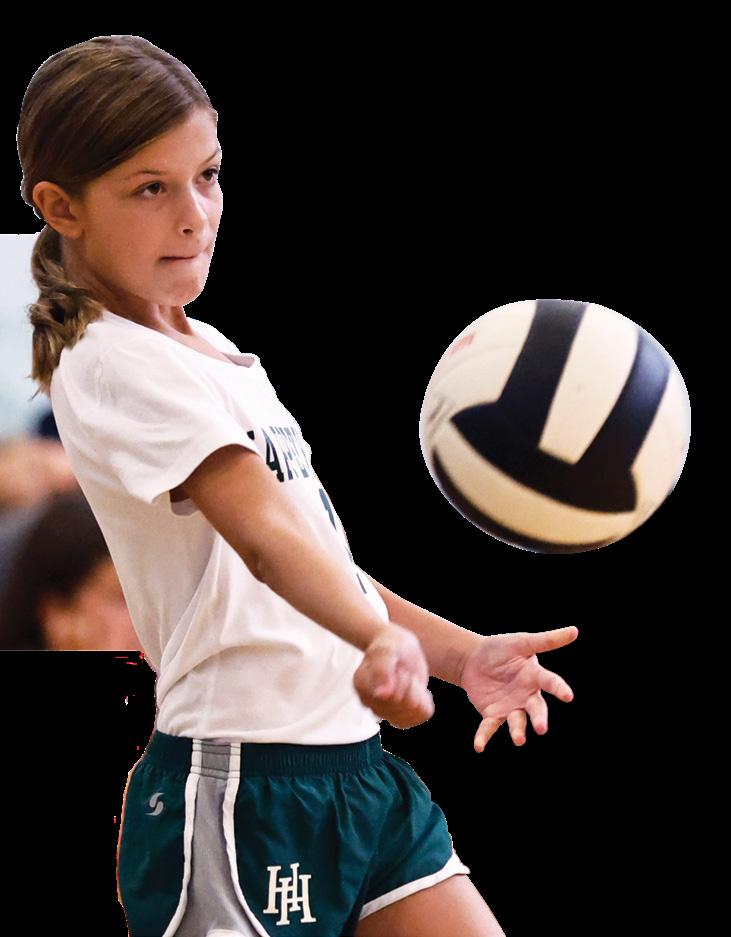

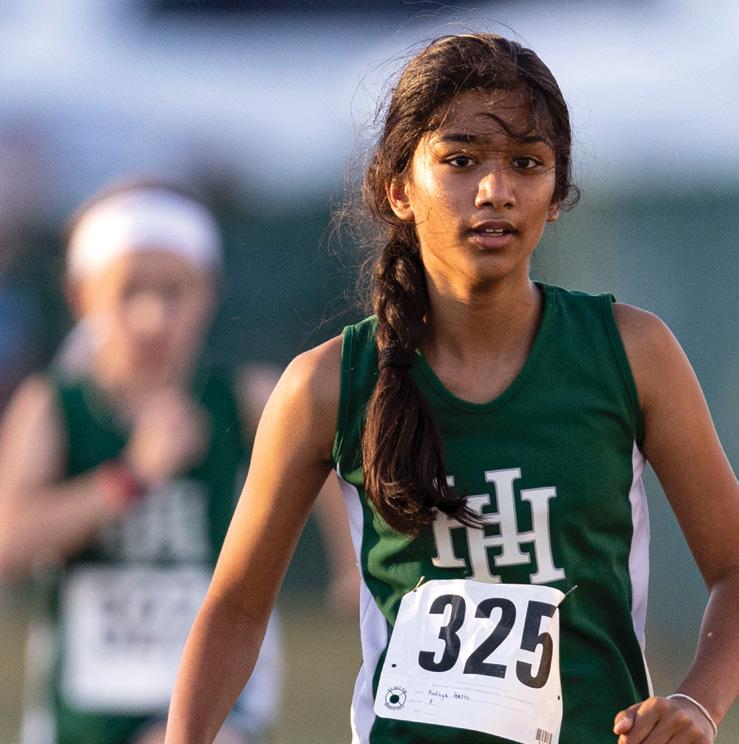

The middle school Life Balance program aims to help girls learn healthy skills to navigate challenges and build resilience in their academic, social, and emotional lives. We build these skills through interactive lessons, guided discussions, and self-reflection. Students gain skills and confidence in communicating, critical thinking, and self and social awareness. Life Balance lessons are developmentally appropriate according to grade level.
5th Grade
Students build skills to navigate their transition to Harpeth Hall. These skills include: building an emotional vocabulary and emotional regulation skills, resilience, communication styles, problem-solving, equity and inclusion, healthy friendships, beginning stages of puberty, and emotion regulation skills
6th Grade
Students identify Harpeth Hall values and clarify their own values. Students gain skills in navigating friendships, perspective taking, digital citizenship and safety, body image and nutrition, puberty, and transitioning to 7th grade.
7th Grade
With many new students joining the class this year, students focus on team building, enhancing communication skills, navigating relational aggression, and being inclusive. Students also build skills in stress management, emotion regulation, and identifying strengths in themselves and others.
8th Grade
As student leaders of the middle school community, students engage in self-assessments to develop self-knowledge. As they look to transition to high school, students dive into important issues facing adolescents today, including: body image and eating disorders, alcohol and vaping education, stress management and coping skills, healthy partnerships and boundaries, healthy communication and communication styles, relational aggression, inclusion, and social media communication.



Professional librarians and technology specialists teach information literacy skills at all grade levels and across all disciplines. These skills are taught collaboratively with the classroom teacher and within the context of the curriculum to enhance specific projects and assignments. Students learn the entire research process, from accessing and evaluating materials to presenting research and properly citing sources. Students are taught to locate and evaluate sources, organize information, and understand how to avoid plagiarism. Librarians present book talks and create reading lists to assist students in finding just the right books to read. When students graduate, they have the skills to perform sophisticated research, be responsible digital citizens, and feel comfortable using a variety of software and online tools.
Scholars Engaged in Extending Knowledge (SEEK)
SEEK, which stands for Scholars Engaged in Extending Knowledge, is a year-long independent study opportunity for 7th and 8th grade students. While any 7th or 8th grader may apply to SEEK, the program is designed to create a space for students who are self-motivated and exceptionally curious about a particular topic to explore it further with the support of a faculty mentor. The SEEK Committee guides students through the process of designing a project that includes both research and the creation of an academic product that requires them to apply their research. In the spring, students present their projects to their middle school peers and are celebrated in an all-school assembly.
Leadership Development
Harpeth Hall’s leadership program sees every girl as a leader. Grounded in respect, integrity, individuality, goodness, and trust, girls hone their leadership skills through a variety of experiences, including public speaking, classroom presentations, on the athletic field, on stage, and in interactions with the greater community through service learning and internships.
Advanced Orchestra
Students participating in this audition-only ensemble rehearse and perform a varied repertoire spanning many different musical periods and styles at an advanced level. One to two years of experience on their instrument is a prerequisite for this class. Middle school advanced orchestra meets once a week before school.
Honeybear Singers and 56 Magnolia
Students eager for additional singing and performing opportunities can join 56 Magnolia in 5th and 6th grades and Honeybear Singers in 7th and 8th grades. In the younger grades, the group focuses on pop and oldies and uses riser choreography to entertain its audiences. The program for our older students emphasizes aural skills, and the ensemble generally sings and performs contemporary music.
Lego League Robotics
In partnership with the FIRST Lego League, our robotics competitive team focuses on applying coding, engineering, and teamwork to accomplish missions using Lego Spike Prime robots. In addition to learning a block-based coding language and programming strategies, students identify and solve an engineering problem connected to the theme for the year. Previous themes include how to be an animal ally, solving the world’s trash problems, and human exploration of space. Harpeth Hall’s well-established middle school robotics program has earned regional and state awards, demonstrating the girls’ coding and engineering design prowess.
Community Time
Students have additional opportunities to grow their talents during community time activities such as Model United Nations, Youth Legislature, Library Leaders, and Intersections, the Middle School Literary Magazine.

SCAN HERE to see all clubs and activities offered to Harpeth Hall Middle School students
